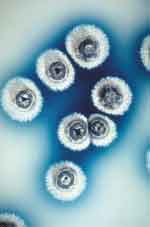Life Sciences and Chemistry
Articles and reports from the Life Sciences and chemistry area deal with applied and basic research into modern biology, chemistry and human medicine.
Valuable information can be found on a range of life sciences fields including bacteriology, biochemistry, bionics, bioinformatics, biophysics, biotechnology, genetics, geobotany, human biology, marine biology, microbiology, molecular biology, cellular biology, zoology, bioinorganic chemistry, microchemistry and environmental chemistry.

Gardens in space
A model of a system for growing plants to plan biological experiments in space has just left the company of ROVSING, in Ballerup near Copenhagen, on its way to ESA’s European Space Research and Technology Centre (ESTEC) in the Netherlands.
The full name of this experiment reference model is European Modular Cultivation System Experiment Reference Model (EMCS ERM). This will be used at ESTEC to plan and carry out experiments for growing plants in space. Then in 2003 the EMCS Flight Model will

No association between ageing gametes and birth defects
Authors of a research letter in this week’s issue of THE LANCET conclude that there is no evidence to support the belief that sexual intercourse too soon or two long after ovulation is associated with an increased risk of birth defects and Down’s syndrome.
For many years, the ageing of gametes as a result of prolonged retention in the female reproductive tract before fertilisation has been circumstantially associated with major birth defects. Joe Leigh Simpson and colleagues from Baylor Coll

Cutting edge – Scientists have combined a cutting ribosyme activity with an unwinding helicase activity
Scientists have long toyed with the idea of putting to work a special class of biological catalysts, called ribozymes, as therapeutic agents. These molecular scissors would harness the activities of overly active genes that contribute to diseases like cancer by cutting their immediate products, messenger RNAs, into unusable pieces. The advantage of this approach, is that these molecules can be made to recognize very specific targets. This is reported in this month issue of EMBO reports.
Up u

Scientists sequence Nature’s antibiotic factory
The genome sequence of Streptomyces coelicolor , one of the family of common soil bacteria that produce more than two thirds of the world’s antibiotic medicines, will be published in the journal Nature this week.
Streptomyces are almost ubiquitous in the soils and are responsible for its familiar ‘earthy’ smell. The genome data, collected by British scientists from the John Innes Centre and The Wellcome Trust Sanger Institute, is already being used in research that will help de

Choosing healthy embryos in IVF
A revolutionary method for detecting which human embryos are most likely to develop successfully to the stage at which they implant in the womb has been developed by scientists at the University of York and clinicians at Leeds General Infirmary.
The research has been funded by the Medical Research Council.
The discovery, if confirmed in clinical trials, could bring new hope for many couples undergoing fertility treatment since current failure rates are high. One of the problems is that e

An Escort Protein Discovered for Ubiquitous Ras, Whose Gene Mutates in 30 to 60% of All Cancers
In order to function properly, living organisms need to eliminate defective cells. This rule is however not always abided by, as evidenced by cancer cells which no longer carry out the tasks originally set for them and yet continue to proliferate, as though they were ” ignoring ” commands from their environment. Cancer can thus be defined, inter alia, as an ailment affecting signal transduction.
A team working at the Institut Curie (Inserm Unit 528) have been looking into information-con